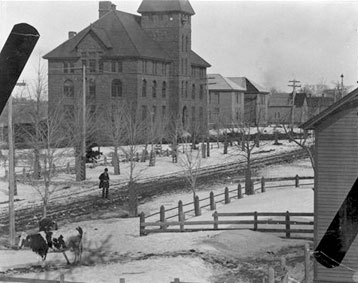A Sense of Place
A photographic essay linking location, community and campus in the Copper Country |
Changing Campus
The Michigan College of Mines, later Michigan Technological University, was established to train young men for careers as mining engineers all over the world. The Keweenaw’s unique geological resources and many operating mining companies made it an ideal site for this educational undertaking. The campus has changed a bit through the years, and cattle no longer graze the grounds.
|
Though originally envisioned by State legislature in 1861, the Michigan College of Mines did not become a reality until 1885, admitting nine students in the fall of 1886. By the end of its first academic year, 23 students attended classes in rented facilities above the village of Houghton’s fire hall. At that time, the future site of the permanent campus was little more than a rocky field on the other side of the Shelden and Columbia stamp mill on Portage Lake, east of Houghton. |
Built from native Jacobsville sandstone, construction began on Hubbell Hall in 1888; it marked the beginning of Michigan Tech’s tradition of innovative and imposing architecture. Students attended classes in the building first known as State or Science Hall even before work was completed in 1890. Though demolished in 1968, Hubbell Hall remains an iconic image of the University’s early days. |

Hubbell Hall, Michigan College of Mines
MTU Photographic Collection
Neg 01017
|
|
|
The 1960s and ‘70s brought a new look to Michigan Tech. US Highway 41 was rerouted and new buildings were raised to overlook the mall. The University’s physical presence expanded to include a new forestry complex and athletic facilities up the hill from the main campus. The traditional engineering curriculum was enhanced as well. Liberal arts were incorporated into campus offerings to appeal to a growing student body. |
|

